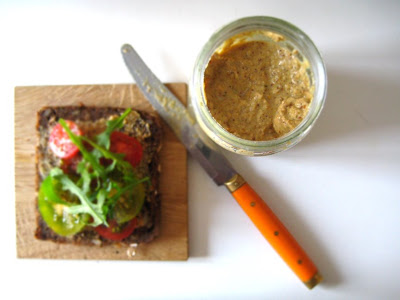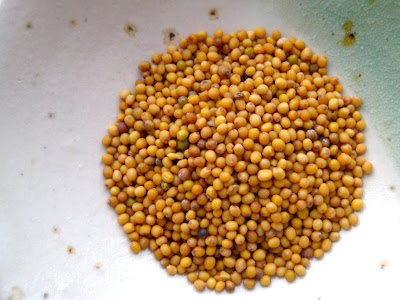If you’ve lived in Toronto at any point in your life, you will have heard of Pusateri’s Fine Foods. It’s a very upscale grocery store that sells gourmet everything; even the toilet paper is special.
Seeing as it is so very close to my house, I sometimes find myself in there, roaming the seductive, dimly-lit aisles just to check out all the things I can’t afford, but like to salivate over. I know that one day, I too will be able to purchase the $130 bottle of balsamic vinegar di Modena, just like the woman dripping with diamonds, except that I will still be happily wearing my moccasins from Value Village and my dad’s flannel shirt. I digress…
One of the things that always captures my imagination is the mustard aisle. How can there be so many different varieties and so many flavours? Honey mustard, Dijon mustard, whole grain, curry mustard, merlot mustard, tequila mustard, tropical mango mustard, and…I’m not kidding, red raspberry wasabi mustard. I saw it with my own eyes. With the prices just about as outrageous as the aromas, I wonder how such a humble seed could cost so much money. This leads me to my next penny-pinching culinary adventure: DIY gourmet mustard. For less than a dollar, you can have a jar of home-made mustard that will knock the socks off any of those derisory Dijons.
A word on the health benefits of mustard
You didn’t think you were getting away with just the recipe, did you? This must be your first time here.
The unique healing properties of mustard seeds can partly be attributed to their home among the Brassica foods found in the cruciferous plant family. Remember those? I wrote about them here.
Like other Brassicas, mustard seeds contain plentiful amounts of phytonutrients called isothiocyanates, which have been repeatedly studied for their anti-cancer effects. In animal studies – and particularly in studies involving the gastrointestinal tract and colorectal cancer – intake of isothiocyanates has been shown to inhibit growth of existing cancer cells and to be protective against the formation of such cells.
Mustard seeds are also a very good source of selenium, a nutrient which has been shown to help reduce the severity of asthma, decrease some of the symptoms of rheumatoid arthritis, and help prevent cancer. They also qualified as a good source of magnesium. Like selenium, magnesium has been shown to help reduce the severity of asthma, to lower high blood pressure, to restore normal sleep patterns in women having difficulty with the symptoms of menopause, to reduce the frequency of migraine attacks, and to prevent heart attack in patients suffering from atherosclerosis or diabetic heart disease.
Mustard seeds are even a very good source of omega-3 fatty acids! Wow! They also contain considerable amounts of iron, calcium, zinc, manganese, magnesium, protein, niacin and dietary fiber.
Commercial mustards, even expensive ones often contain sulfites; nasty preservatives that I wrote about in this post.
Making your own mustard will obviously help you avoid this unwanted addition.
Mustard is also a great condiment choice for people watching their waistlines. While it is very flavourful, mustard is low in calories and fat, compared to hefty mayonnaise, and ketchup, which is loaded with sugar.
Okay, now to the good stuff.
This recipe is for one very hot mustard. You can omit the black mustard seeds if you prefer something milder, but even the yellow seeds produce a potent condiment, not for the faint of heart. If you have ever been to France, this is the equivalent of their grocery store mustard, but in North America we’re used to the bright yellow stuff that graces ballpark franks, which this is certianly not. Be warned.
I found that the flavour of the mustard was slightly bitter right after I blended it, but this disipated after a couple days or so, and then became a full-bodied, eye-opener. Enjoy!
DIY Gourmet Mustard
Ingredients:
4 Tbsp. yellow mustard seeds (mild flavour)
2 Tbsp. black mustard seeds (spicy flavour)
1/3 cup white wine vinegar
1/3 cup apple cider vinegar (I used just apple cider vinegar, it’s much healthier!)
1 tsp. sweetener (agave, honey, maple syrup)
½ tsp. sea salt
1 ½ tsp. grated onion
¼ tsp. ground pepper
Directions:
1. Combine all ingredients and refrigerate overnight (or for 12 hours) to allow the mustard seeds to soften and absorb the flavours.
2. Place mixture in blender and mix on high for a minute or two, until the seeds have broken and the mustard thickens.
3. Transfer contents to a clean jar and enjoy!
This will keep for about 3 weeks in the refrigerator.
You can add any flavours that you want to this basic recipe. Try fresh herbs like dill, tarragon, or thyme. How about a clove of garlic? Dried fruits? Horseradish? It’s up to you! You can find mustard seeds at some grocery stores, but health food stores will certainly have them in stock. Try to find organic to ensure that the seeds have not been irradiated.
So get creative and start making your very own gourmet mustard today. You will relish every bite.
information resource: whfoods.com





This recipe sounds great… Can this mustard be canned?
Delighted to find your blog! Have just harvested some Red Mustard, Brassica juncea, that has gone to seed. In the past I have used it in dry arrangements. This year MUSTARD!
oh la la, I think this one hits the spot for me. Im going to
try it, sar.
you read my mind Sarah, I was just thinking recently about making some mustard for myself when I had some homemade stuff this past winter…
can’t wait to give it a try!